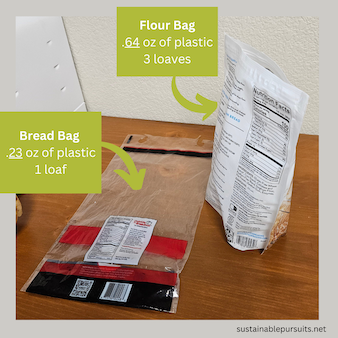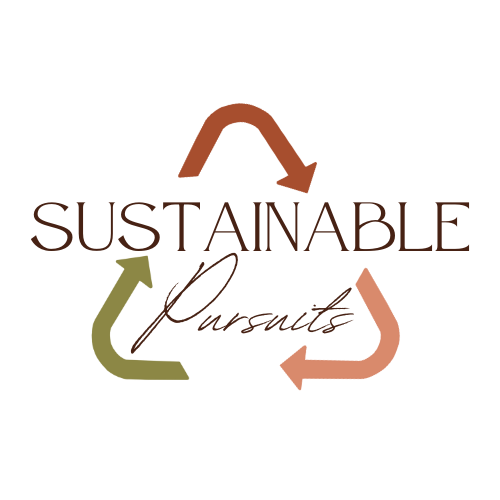This month’s plastic-free bread challenge didn’t go quite as I thought it would. Reflecting on the month, it was the gluten-free element that really made things difficult. Things would have gone much smoother and there would be more plastic-free options if I could eat regular flour.
I say that because this month has taught me that there are 2 key factors for plastic-free bread. One is using a cloth bread bag to buy bread from the bakery. The other option is making your own bread and baked goods. However, when you’re gluten-free, you can’t buy bread from the bakery unless they have GF options. And the problem I encountered with making GF bread is that all the GF flours are in plastic bags.
Below is a list of how the month went and how much plastic was reduced. I also have suggestions on reducing plastic even if you’re gluten-free and how sustainable these new habits are.
Here’s a recap of the bread challenge activities
- Obstacles you’re likely to encounter with the bread challenge if you’re gluten-free.
- How to find plastic-free flours using either the bulk food stores or Azure Standard (Azure has some but not all of their GF flours in paper bags).
- What life was like before plastic, how to store bread, and why we use plastic bread bags.
- I went more in-depth in last week’s update on how the bread-making and shopping were going.
Progress since last week’s update
- Yes! I can use my own bread bag at Panera Bread! So for those who can eat wheat or sourdough, this is a good option.
- Just got my Einkorn sourdough starter… Still figuring out the timing to feed the starter and when to bake with it.
- Found lots of Einkorn recipes I’m excited to try!
This month, I did have to use 2 packages of baked goods in regular plastic packaging, they were the sliced GF bread and GF tortillas. Had to use them because my GF sandwich bread hadn’t been turning out too well. And what I was baking didn’t cover everything I needed. I have a set baking time in my schedule but to meet my baked goods demand I will have to add an additional baking time, maybe two.
Calculating the plastic used this month
I made 3 loaves of bread using the GF flour that comes in a plastic bag, the plastic bag weighed .64 oz and held 2 lbs of flour. From what I can tell, this is a standard plastic flour bag but weights may vary by brand. The plastic bread bags from the store-bought GF bread weighed an average of .23 oz (that’s including the plastic bread clip).

Here’s what those numbers break down to:
1 plastic bread bag = .23oz, 1 plastic bag with 2 lbs flour = .64oz
1 plastic bag of flour = 3 loaves of bread
3 plastic bread bags = 3 x .23oz (weight of plastic bread bag) = .69oz of plastic.
So, did I reduce my plastic waste by making my own bread? No. At least not the way I was going about it. The plastic bag of flour I was using was for 2 lbs. I’ll weigh the plastic bag from a 4 lb bag of flour soon to see if that makes any difference.
The takeaway from this experiment is that if you’re using flour in a plastic bag, you might as well spare yourself the hassle and buy your bread from the store. That’s not to say there aren’t a lot of great reasons to make your own bread. But from a plastic-waste perspective, it isn’t worth it unless you can use flour that comes in paper bags.
But there is a solution for those who use the GF flours!
If you have a bulk food store in your area you can cut out the plastic by buying your flour there. After talking with the bulk food stores in my area, I learned that most of their GF flours are delivered in large paper bags. Why do the bulk bags of GF flour come in paper and the smaller GF flour bags come in plastic, I don’t know. But that’s a huge plus for the bulk stores because paper bags are considered “very recyclable”. (To learn more about recycling best practices, please see my review of Jennie Romer’s book, Can I Recycle This?)
Personal impact for this month’s Plastic-Free Bread Challenge
I succeeded in using the cloth bread bags at the farmer’s market and at Panera Bread. Since I bought 2 loaves this month using my bread bags, that’s .46 oz of plastic waste reduced (2 x .23).
If I had gotten my flour from the bulk food store I would have saved another .69 oz of plastic (see calculations above). I also made my own muffins/banana bread. Since I was buying about 2 plastic containers worth of muffins before the plastic-free bread challenge that’s 2 packages of plastic saved.
At the beginning of the plastic-free bread and baked goods challenge, I estimated I go through 9 plastic bags/containers. This month, I used 2 plastic bread bags and a flour bag (the equivalent of 3 plastic bread bags). So, not as much of a reduction as I’d like but in the future I should be able to reduce even more plastic by buying bulk.
Is this plastic-free bread challenge sustainable?
I’m still figuring out what parts of this challenge I can continue to maintain. The muffins and batter breads (like banana bread) I don’t mind making. They’re usually pretty quick and easy, plus I can use up any bananas that are about to go bad. Making the actual sandwich bread is proving to be another matter. So, I’ll have to see how well the Einkorn sourdough does.
Of the new habits I worked on this month, I feel most confident that I can continue to get flour from the bulk food store and making my own muffins/banana bread. I’m still testing my GF tolerance with the regular sourdoughs, but if I can continue to eat them I will continue to use my cloth bread bags to buy them.
Once I get into a rhythm with my sourdough starter, and find recipes that work for me, I will hopefully be more successful with my baked goods. I will definitely try to keep my regular baking time, and try to add additional times next month. This way I can experiment more with the Einkorn sourdough starter. In the meantime, I will probably keep buying the GF sandwich bread from the store and taking the bread bags to the recycling center.
Next month I will be focusing on plastic wrap alternatives, as well as continuing with the bread experiment 🙂

